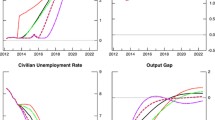Summary
The very slow growth of the broad money supply has been a primary source of U.S. economic weakness in 1990 through 1992. The velocity link between M2 and the subsequent level of nominal GDP has not declined. But changes in bank reserves brought about by open market operations have had much less effect onM2 than the Fed anticipated for two reasons: (1) reserve requirements now apply to only a small fraction of totalM2; and (2) the new bank capital requirements limit some banks’ ability to lend. The Federal Reserve failed to appreciate the importance of these conditions and misjudged the strength of the monetary policy stimulus that it was providing.
Similar content being viewed by others
Additional information
Professor of Economics, Harvard University, and President of the National Bureau of Economic Research.
Sixth Tinbergen Lecture delivered on October 2, 1992, in The Hague for the Royal Netherlands Economic Association.
Rights and permissions
About this article
Cite this article
Feldstein, M. The recent failure of U.S. monetary policy. De Economist 141, 29–42 (1993). https://doi.org/10.1007/BF01144776
Issue Date:
DOI: https://doi.org/10.1007/BF01144776




